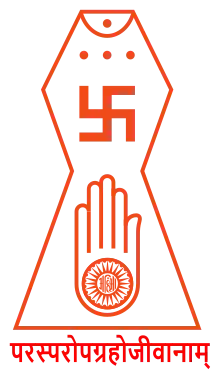Bhabra
Bhabra or Bhabhra is an ethno-linguistic and religious group who are from Punjab region which follow Jainism.

| Part of a series on |
| Jainism |
|---|
 |
| Part of a series on |
| Punjabis |
|---|
 |
_with_cities.png.webp) Punjab portal |
History and Origin
The Bhabra community has had a close historical association with Jainism. It is believed to be connected with the Bhavadar or Bhavada Gachchha to which the legendary Jain Acharya Kalakacharya belonged to. They may have originated from the Bhabra town (32° 13' 30": 73° 13').[1] Inscriptions suggest that Bhavada Gachchha had survived until the 17th century.
Jainism has been present in Punjab since ancient times. This is where Alexander the Great encountered Gymnosophists and Xuanzang met both Digambara and Swetambara monks.[2] According to Shatrunjaya Mahatmya of Dhaneshwar Suri, Javad Shah of Taxila had restored Shatrunjaya Tirth and brought an idol of Lord Adinath from Taxila and installed it at Shatrunjaya.
Vaar 8 Pauri 12 of 24 of Vaaran Bhai Gurdas (1550-1620 CE)[3] says: "kaytarhiaan hee baaneeay kitarhay bhaabharhiaan suniaaray",[4] there are many traders and many Bhabras are goldsmiths.
In "Romantic Tales from the Punjab" Charles Swynnerton relates a folk tale about several girls. It mentions a girl being a Bhabra, and mentions them being strictly vegetarian.[5] In the 17th century, Fray Sebastien Manrique met them in Amritsar district.[6] Their presence has been noted in the Mughal period,[7] and in the 19th century.[8]
The original home region of the Bhabras is now in Pakistan. While all the Bhabras left Pakistani Punjab in 1947, for India. Many cities still have sections named after Bhabras.
- Sialkot: All the Jains here were Bhabra and mainly lived in Sialkot and Pasrur. The Serai Bhabrian and Bhabrian Wala localities are named after them. There were several Jain temples here before partition of India.
- Pasrur: Pasrur was developed by a Jain zamindar who was granted land by Raja Maan Singh. Baba Dharam Dass belonged to the zamindar family who was murdered on a trading visit.[9]
- Gujranwala: Two old Jain libraries managed by Lala Karam Chand Bhabra were present here which were visited by Ramkrishna Gopal Bhandarkar[10]
- Lahore: There were Jain temples at localities still called Thari Bhabrian and Gali Bhabrian.
- Rawalpindi: Bhabra Bazar is named after them.
In India they have been present at:
After 1947 Partition, most of displaced bhabra families were resettled in Ludhiana, Punjab and Ambala, Haryana. [11]
In Delhi, the majority of Jains in Rup Nagar locality also have their origin in west Punjab.[12]
References
- Sarupa-Bharati: Or the Homage of Indology, Being the Dr. Lakshman Sarup ...by Vishveshvaranand Vedic Research Institute - Indic studies - 1953 - Page 247
- Life and Culture in Ancient India: From the Earliest Times to 1000 A.D. By Bhanwarlal Nathuram Luniya, 1978, Pub. Lakshmi Narain Agarwal
- Vaar 8 Pauri 12 Castes and working classes Archived August 25, 2005, at the Wayback Machine
- Vaar 8 Pauri 12 of 24 of Vaaran Bhai Gurdas Archived August 25, 2005, at the Wayback Machine
- Romantic Tales from the Punjab, Charles Swynnerton - 1892
- Travels of Fray Sebastien Manrique, 1629-1643: A Translation of the ... by Sebastião Manrique, Henry Hosten - Missions - 1927- Page 225
- The Punjab Under the Mughals by Muhammad Akbar - Punjab (India) - 1948- Page 19
- Early Nineteenth Century Panjab: From Ganesh Das's Char Bagh-i-Panjab
- Baba Dharam Dass Tomb in Pasrur
- The two Jain Libraries at Gujranwala by Ramkrishna Gopal Bhandarkar in A Catalogue of Sanskrit Manuscripts in the Library of the Deccan College, by Deccan College Library, Franz Kielhorn- 1884 -- Page 12
- "Harking Back: Jain temples of Lahore and the 'naked sages'". Dawn. 22 November 2015.
- The Mūrtipūjaka Śvetāmbara Community in North Delhi, Akiko Shimizu, Centre of Jaina Studies Newsletter, Issue 3: February 2008